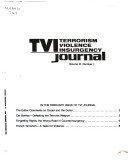Difference between revisions of "TVI Journal"
| Line 4: | Line 4: | ||
In 1970 Lund had, with [[Robert K. Brown]], founded [[Paladin Press]]. In 1974, Lund and Brown, according to the Paladin Press official history, 'split over the direction the company should take. Lund wanted to expand Paladin’s coverage of topics, while Brown wanted to start a magazine. Lund bought out Brown, who founded ''[[Soldier of Fortune]]'' magazine'.<ref>Paladin Press [http://www.paladin-press.com/company_history Company History]. Accessed 3 January 2015.</ref> Paladin was, according to [[Edward S. Herman]] and [[Gerry O'Sullivan]], was 'the premier producer of assassination and "unorthodox" combat manuals in the United States. In 1983, Lund traveled to El Salvador with a Soldier of Fortune contingent of mercenaries to help "train" certain elements of the Salvadoran military, A photo in Soldier of Fortune, September 1983, shows Lund with a Salvadoran soldier and the bodies of two dead "guerrillas," Robert Chapman, Lund's associate editor, was with the CIA for twenty-seven years and wrote ''The Crimson Web of Terror'' for Paladin Press.'<ref>See Herman and O'Sullivan [[Brian Jenkins, extract from The "Terrorism" Industry]]</ref> | In 1970 Lund had, with [[Robert K. Brown]], founded [[Paladin Press]]. In 1974, Lund and Brown, according to the Paladin Press official history, 'split over the direction the company should take. Lund wanted to expand Paladin’s coverage of topics, while Brown wanted to start a magazine. Lund bought out Brown, who founded ''[[Soldier of Fortune]]'' magazine'.<ref>Paladin Press [http://www.paladin-press.com/company_history Company History]. Accessed 3 January 2015.</ref> Paladin was, according to [[Edward S. Herman]] and [[Gerry O'Sullivan]], was 'the premier producer of assassination and "unorthodox" combat manuals in the United States. In 1983, Lund traveled to El Salvador with a Soldier of Fortune contingent of mercenaries to help "train" certain elements of the Salvadoran military, A photo in Soldier of Fortune, September 1983, shows Lund with a Salvadoran soldier and the bodies of two dead "guerrillas," Robert Chapman, Lund's associate editor, was with the CIA for twenty-seven years and wrote ''The Crimson Web of Terror'' for Paladin Press.'<ref>See Herman and O'Sullivan [[Brian Jenkins, extract from The "Terrorism" Industry]]</ref> | ||
| − | According to [[Alex Schmid]] and [[ | + | According to [[Alex Schmid]] and [[Albert Jongman]], 'its original target readership were probably fellow journalists and corporate executives, rather than counterinsurgency officials'.<ref name="Schmid"> A. Schmid and A. J. Jongman, ''Political Terrorism: A new guide to actors, authors, concepts, data bases, theories and literature'', Transaction Publishers, 1988. p. 154.</ref> |
In 1985 the Journal was taken over by [[Brian Jenkins]] the [[Rand Corporation]] director for studies on subnational conflict. Under Jenkins the journal was renamed [[TVI Report]] with a new ISSN (1041-8474). It continued publication until around 1999, according to Worldcat.<ref>Worldcat [http://www.worldcat.org/title/tvi-report/oclc/13212553&referer=brief_results TVI Report]. Accessed 3 January 2015.</ref> | In 1985 the Journal was taken over by [[Brian Jenkins]] the [[Rand Corporation]] director for studies on subnational conflict. Under Jenkins the journal was renamed [[TVI Report]] with a new ISSN (1041-8474). It continued publication until around 1999, according to Worldcat.<ref>Worldcat [http://www.worldcat.org/title/tvi-report/oclc/13212553&referer=brief_results TVI Report]. Accessed 3 January 2015.</ref> | ||
Revision as of 07:36, 4 January 2015
TVI Journal (or Terrorism, Violence, Insurgency Journal ISSN: 0195-8003[1]) was founded in 1979/80, in San Diego. It was edited by journalists Mark Monday and Robert Chapman and published by Peder Lund.

In 1970 Lund had, with Robert K. Brown, founded Paladin Press. In 1974, Lund and Brown, according to the Paladin Press official history, 'split over the direction the company should take. Lund wanted to expand Paladin’s coverage of topics, while Brown wanted to start a magazine. Lund bought out Brown, who founded Soldier of Fortune magazine'.[2] Paladin was, according to Edward S. Herman and Gerry O'Sullivan, was 'the premier producer of assassination and "unorthodox" combat manuals in the United States. In 1983, Lund traveled to El Salvador with a Soldier of Fortune contingent of mercenaries to help "train" certain elements of the Salvadoran military, A photo in Soldier of Fortune, September 1983, shows Lund with a Salvadoran soldier and the bodies of two dead "guerrillas," Robert Chapman, Lund's associate editor, was with the CIA for twenty-seven years and wrote The Crimson Web of Terror for Paladin Press.'[3]
According to Alex Schmid and Albert Jongman, 'its original target readership were probably fellow journalists and corporate executives, rather than counterinsurgency officials'.[4]
In 1985 the Journal was taken over by Brian Jenkins the Rand Corporation director for studies on subnational conflict. Under Jenkins the journal was renamed TVI Report with a new ISSN (1041-8474). It continued publication until around 1999, according to Worldcat.[5]
After 1985, the journal was described as having contributors that are 'academic experts in the field of terrorism and officials with direct responsibilities and firsthand experiences in dealing with the problems they address.'[6]
People
- Brian Jenkins, editor from 1985.
- William F. Sater, managing editor circa 1988[6]
Notes
- ↑ Worldcat TVI Journal. Accessed 3 January 2015.
- ↑ Paladin Press Company History. Accessed 3 January 2015.
- ↑ See Herman and O'Sullivan Brian Jenkins, extract from The "Terrorism" Industry
- ↑ A. Schmid and A. J. Jongman, Political Terrorism: A new guide to actors, authors, concepts, data bases, theories and literature, Transaction Publishers, 1988. p. 154.
- ↑ Worldcat TVI Report. Accessed 3 January 2015.
- ↑ 6.0 6.1 A. Schmid and A. J. Jongman, Political Terrorism: A new guide to actors, authors, concepts, data bases, theories and literature, Transaction Publishers, 1988. p. 155.